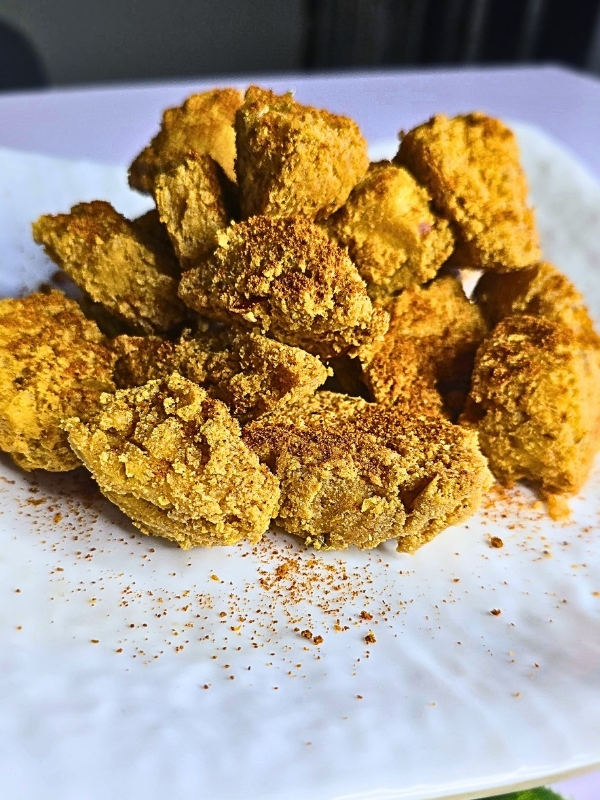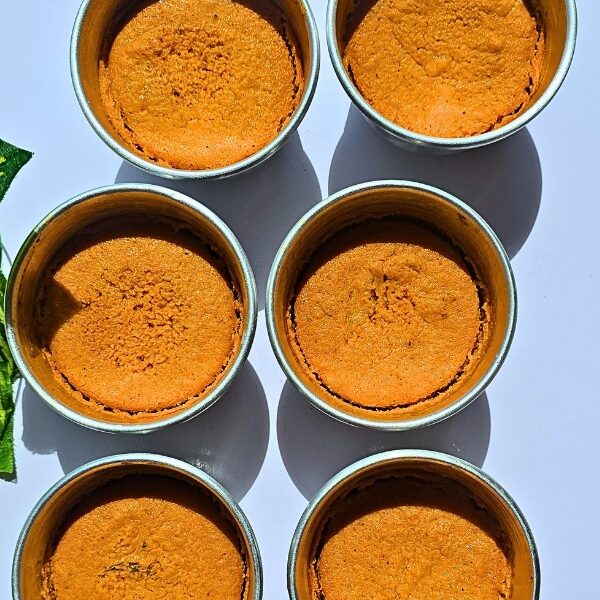This is a post on best Awara Recipe (Tofu)
When I was in primary school up in the northern part of Nigeria, awara was one of my most cherished treats and still is.
Every break time, I would hurry out of the classroom and rush to the little roadside stall near the school gate where the wara (awara) seller stood, his tray balanced on his head. He would call out in Hausa, “Wara! Wara! Beske!”, and all the pupils would swarm around him.
I remember how eager I was to buy two or even three pieces. With the warm, slightly chewy texture dipped into spicy pepper sauce, every bite felt like a reward for surviving the morning lessons and ever since those days, awara has held a nostalgic place in my heart.
As I grew older, I decided I should learn how to make it myself not just for the flavor, but also to preserve that connection to home, memory, and culture.
Thus, in this post, I’ll take you from bean to plate: how to make awara (tofu) from soybeans, using lemon water as a coagulant, and frying with groundnut oil to golden perfection. Along the way, I’ll share tips, pitfalls, and personal touches to help your awara be soft, tasty, and crispy.
Why This Awara Recipe (Tofu)?
But first, why bother making awara at home when you can buy it on the road? Here are several compelling reasons:
-
Freshness & Health: When you make it yourself, you control every ingredient—no preservatives, no hidden chemicals.
-
Cost‑effective: Buying raw soybeans and making tofu yourself is often cheaper in the long run than constant street purchases.
-
Nutrition: Soybean tofu (awara) is high in protein, contains all essential amino acids, and is rich in calcium, iron, and unsaturated fats.
-
Dietary flexibility: For vegetarians, vegans, or lactose-intolerant individuals, it’s a great plant‑based protein.
-
Cultural heritage: Home making keeps alive the traditional skill, connecting us to our roots.
Thus, whether for health, culture, or savings, making your own awara is worthwhile.
Quick Overview of Awara Recipe (Tofu) Process
To make it easy for you, here are simple outline of the steps:
-
Sort, clean, and soak the soybeans
-
Dehull / remove coats (peeling)
-
Grind soaked beans into slurry / paste
-
Sieve / filter to get soymilk (removing okara)
-
Boil the soymilk with careful stirring
-
Add coagulant (lemon water) gradually to curdle
-
Allow curds and whey to separate
-
Drain / press the curds (forming tofu block)
-
Slice into pieces
-
Finally, fry in groundnut oil until golden
-
Serve with pepper sauce or accompaniments
Each of these steps requires attention, and small adjustments can make the difference between excellent awara and a fail.
Ingredients & Equipment Needed for Awara Recipe (Tofu)
Ingredients
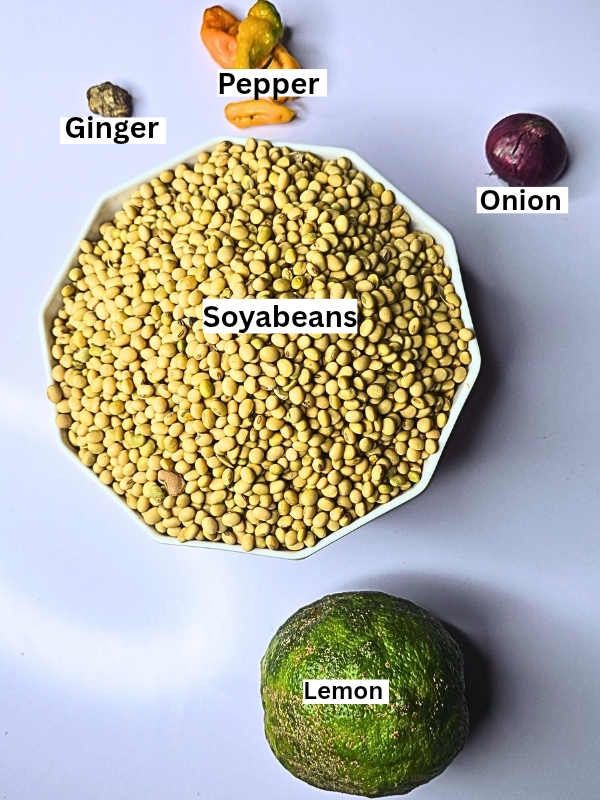
Here is a typical ingredient list (you can scale up or down):
-
4 cups of Soybeans
-
Enough clean water (for soaking, grinding, rinsing, boiling)
-
One lemon juice or lemon water (as coagulant) — freshly squeezed
-
Salt (to taste)
-
Groundnut oil (for frying) — or any neutral cooking oil
-
Optional: a pinch of seasoning (like bouillon/ or spices (pepper, onion)
Note on coagulant: Although in this post we use lemon water, other coagulants such as alum, vinegar, Epsom salt, or fermented millet water (omi ogi) may also be used.
Equipment & Tools for Awara Recipe (Tofu)
You’ll also need:
-
Large bowl (for soaking)
-
Colander or sieve
-
Cheesecloth / muslin cloth or fine cloth (for straining)
-
Blender / grinder
-
Large pot (for boiling soymilk)
-
Stirring spoon / spatula
-
Container or mold for pressing tofu (wooden board or flat tray with weight)
-
Knife (for slicing)
-
Frying pan or deep pot for frying
-
Slotted spoon or frying strainer
It helps if your cloth is clean and food-grade. Cleanliness is paramount to avoid off‑flavors or contamination.
Step 1: Sorting, Washing, and Soaking the Soybeans
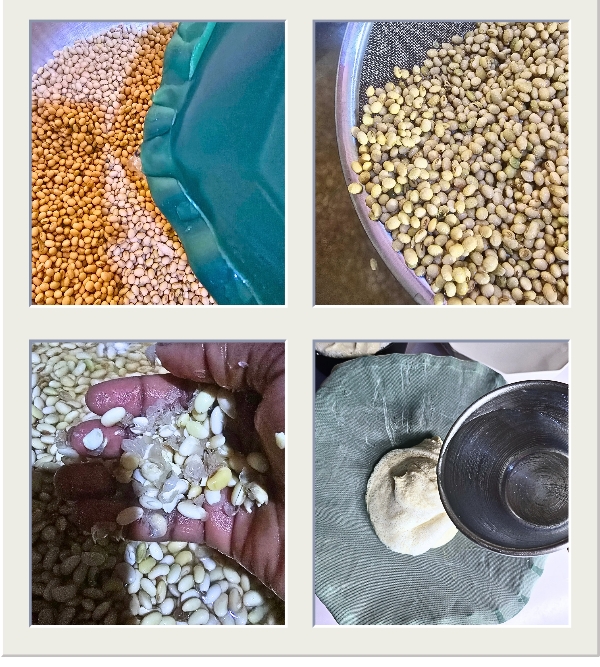
Sorting and Initial Wash
First, pick through your dry soybeans to remove stones, debris, dirt, and broken beans. This helps protect your blender and ensures purity.
Then, rinse the beans thoroughly in clean water. Swirl them and change water until it runs mostly clear.
Soaking
Next, soak the beans in plenty of water (at least 3–4 times their volume) for 6 to 12 hours, or overnight. The beans will swell and soften, making them easier to grind and peel.
Tips & transitions:
-
Meanwhile, cover the bowl with a cloth or lid to prevent dust or insects.
-
Then, If you live in a warm area, you can change soaking water halfway to reduce fermentation or off-smell.
-
Finally, soaking helps to activates enzymes, making the beans easier to digest.
By the end of soaking, the beans should be soft, swollen, and partly split. If they are still very hard, they may need more soaking.
Step 2: Dehulling / Peeling the Soybeans (Removing the Coat)
After soaking, you’ll notice many beans have loosened coats (skins). Removing these helps improve the smoothness of milk and reduces bitterness.
-
First, rub the beans gently in your hands while in water to loosen skins.
-
Then, pour off the floating skins with water.
-
Meanwhile, repeat rinsing until most skins are gone.
This peeling step is optional for some home cooks, but it improves texture. In practice, many recipes skip full dehulling but do partial peeling.
Step 3: Grinding into Slurry / Paste
Now drain the soaked beans (preserve soaking water if desired) and then grind in a blender with water to form a smooth slurry.
-
Use roughly 1 part beans : 2 parts water (by weight or volume) as a starting point
-
Grind in batches, not too much at once
-
The result should be a thick paste or slurry
You may have to adjust water amount so the paste is smooth but not too watery.
Step 4: Filtering / Sieving to Get Soymilk (Removing Okara)
Once you have a smooth slurry, you want to separate the liquid (soymilk) from the solid pulp (okara).
-
Pour the slurry through a cheesecloth, muslin cloth, or fine sieve into a large pot
-
Gather cloth edges and squeeze to extract as much milk as possible
At the end, you should have a pot containing soymilk (the liquid) and a pile of pulp that you can discard or reuse.
Step 5: Boiling the Soymilk Carefully
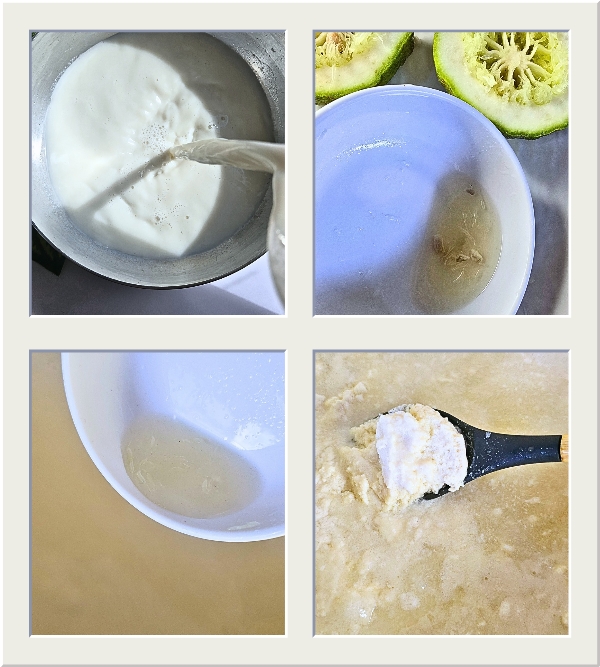
This is a critical stage. The soymilk must be brought to near-boil, but you must watch for foaming and avoid burning or overflowing.
-
Place the pot on medium heat
-
Stir occasionally
-
As the milk warms, foam may form; reduce heat or stir gently to prevent overflow
-
When it begins to bubble, reduce heat to avoid boiling over
Many recipes emphasize stirring, sliding off heat momentarily, or using a bit of oil to suppress foam.
Once the milk is hot, get ready to add the coagulant.
Step 6: Adding Lemon Water to Coagulate / Curdle
Here we use lemon juice / diluted lemon water as the coagulant. The acid helps the soy proteins coagulate and separate into curds (solids) and whey (liquid).
How to prepare lemon water:
-
Squeeze fresh lemon(s).
-
You might dilute with a small amount of water (say 1 part lemon : 1 part water) for easier distribution.
-
Remove seeds.
How to coagulant:
-
When the soymilk is hot (but not vigorously boiling), slowly pour the lemon water into the milk, stirring gently.
-
Add gradually—don’t dump it all at once.
-
After adding, gently stir and then cover the pot and allow the mixture to rest undisturbed.
What you expect to see: The milk separates into white curds and clear or light yellowish whey. The curds will clump and the liquid becomes more transparent.
If nothing happens (no curds), you may need more lemon or let it cool slightly. If curds are very small or break apart, temperature or acid amount may be off.
You may experiment: some people add lemon water in two stages.
This coagulation step is similar to tofu making or cheese curdling in principle.
Step 7: Letting Curds & Whey Separate & Rest
Once coagulation begins:
-
Turn off heat (or reduce to very low)
-
Cover the pot, let it sit undisturbed for 10–20 minutes to allow full separation
-
You’ll see the curds settle and whey rise
At this stage, do not stir aggressively—let gravity help the separation. The curds will firm up.
Step 8: Draining & Pressing the Curds (Forming the Tofu / Awara Block)
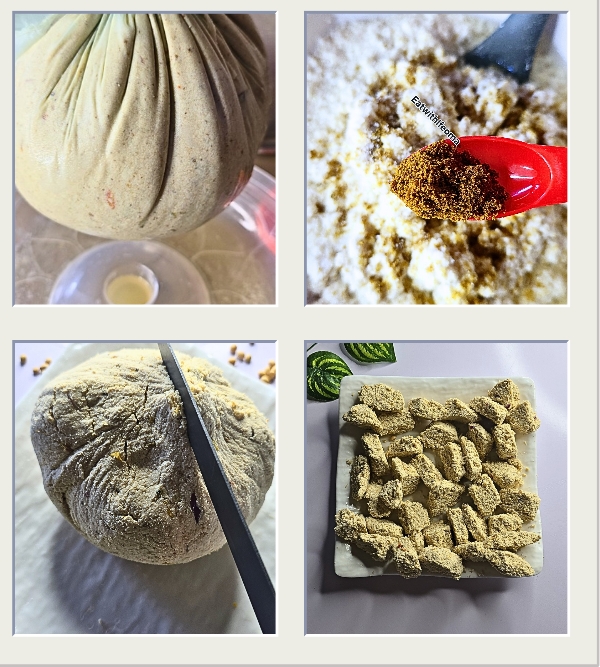
Now you need to drain off the whey and press the curds to create a unified block.
-
Place a cheesecloth / muslin cloth inside a sieve or colander
-
Gently ladle the curds + whey onto the cloth
-
Fold cloth edges over the curds
-
Tie or secure the cloth, and place a weight (flat board + heavy object) on top
-
Let it press for 1 to 2 hours (or more) to remove excess water
You want a block that is firm enough to slice, but not bone-dry. The pressing time controls firmness. Some home cooks press for several hours.
Once pressed, unwrap the block. You now have raw awara / tofu.
Step 9: Slicing into Pieces
First, you start by using a clean knife, slice the pressed block into pieces of your desired thickness and shape — e.g. rectangles, squares, or triangles.
Next you soak the slices briefly in salted water (5–10 minutes) to reduce any residual lemon tang (some cooks recommend this) before frying if you so desire.
Finally, pat dry with a paper towel or clean cloth before frying.
Step 10: Frying in Groundnut Oil
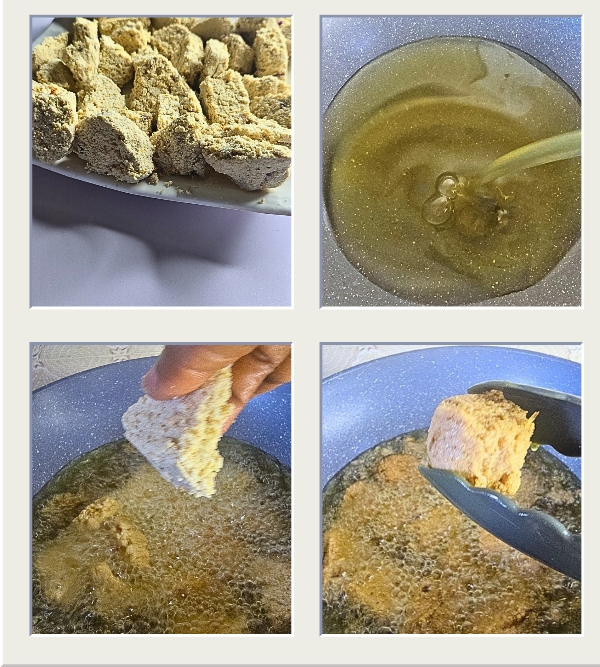
Finally, we fry the awara slices to golden perfection. Use groundnut oil (or any neutral high‑smoke point oil) as requested.
Frying method:
-
First, heat your oil in a deep pan or pot (enough depth so slices can float)
-
Next, test oil by dropping a small fragment—if it sizzles immediately, oil is hot
-
Then, fry slices in small batches, avoid overcrowding
-
Next, fry until golden brown on both sides, flipping if needed
-
Finally, use a slotted spoon to remove, drain on paper towels or wire rack
The result: crispy exterior, tender interior, golden color.
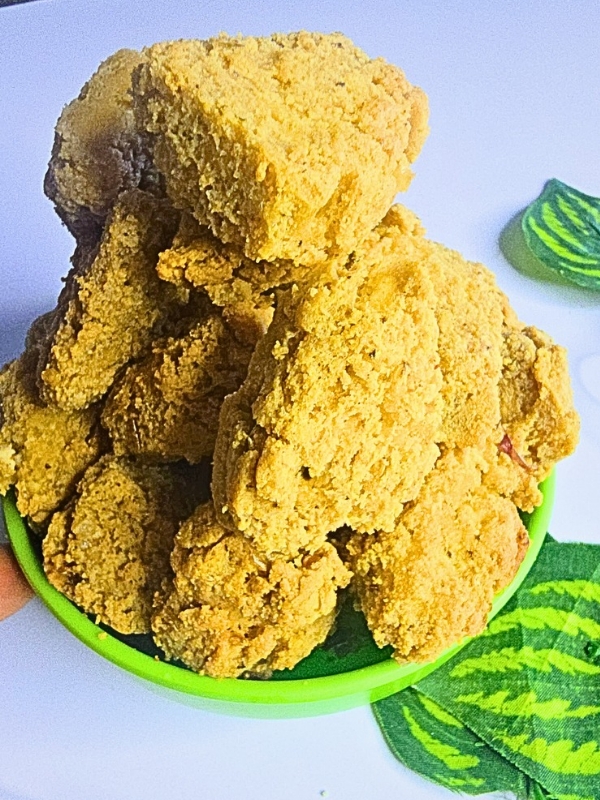
For extra crispness, you may dust slices lightly with flour or starch before frying (optional). Also, you can shallow-fry if you prefer less oil.
Serving Suggestions of this Awara Recipe (Tofu)
Awara is traditionally enjoyed in many ways:
-
Serve hot with pepper sauce / hot sauce
-
Eat with bread, garri, ogi (pap)
-
Use in stews as protein substitute
-
Pair with vegetables, salad, yaji (suya spice)
You may garnish with chopped onions, tomatoes, or fresh herbs.
Tips, Tricks & Solution of Awara Recipe (Tofu)
Here are common issues you might face, and how to fix them:
| Issue | Cause | Solution |
|---|---|---|
| No curds (milk doesn’t separate) | Not enough acid, temperature off | Add more lemon gradually, reduce heat, allow more time |
| Curds too small / crumbly | Over-agitation, too much acid, too high heat | Stir gently, reduce acid amount, lower heat |
| Tofu tastes sour | Too much lemon, insufficient rinsing | Soak slices in salted water briefly, reduce lemon in next batch |
| Block too soft / falls apart | Inadequate pressing | Press longer, use more weight |
| Crispy edges burn before inside done | Oil too hot or slices too thick | Lower heat, fry in batches, thinner slices |
Also, maintain clean utensils, fresh water, and sterility to avoid off-flavors or spoilage.
Nutrition & Health Benefits of this Awara Recipe
Awara / tofu from soybeans offers:
-
High-quality protein (all essential amino acids)
-
Low in saturated fat, good unsaturated fats
-
Calcium, iron, magnesium, potassium
-
Fiber (in residual okara or integrated)
-
Cholesterol-free (plant-based)
-
Good for vegetarians, vegans, lactose-intolerant people
However, moderation is key: fried foods should be balanced with fresh vegetables and whole grains.
FAQ on How to Make Awara/Tofu
Q: Can I use vinegar instead of lemon juice?
A: Yes, white vinegar or apple cider vinegar can act as coagulants, though the flavor will differ slightly. Some people also use alum or Epsom salt.
Q: How firm should I press the awara block?
A: It depends on your preference. For soft awara, press lightly for a shorter time; for firm, press longer with more weight. Overpressing may make it too dry or crumbly.
Q: Can I bake or air-fry instead of deep-frying?
A: Yes, though the crispness will differ. Some prefer shallow-frying or air-frying for a healthier variant.
Q: How long can homemade awara last?
A: Store in refrigeration in salted water or airtight container; it may last 3–5 days. Freeze for longer storage (but texture may change).
Q: Can I flavor the awara (spices, onion, pepper)?
A: Yes. You can mix in ground pepper, chopped onions, or seasoning just before pressing or after slicing, though doing so too early can affect curd formation.
You May Also Like:
